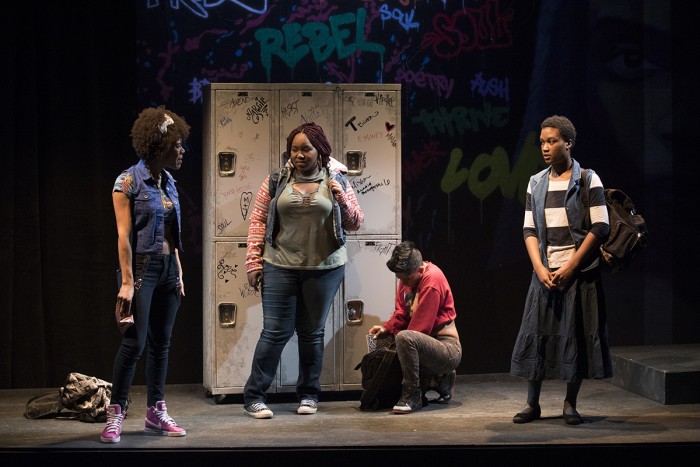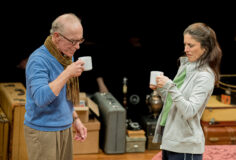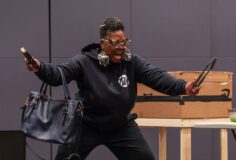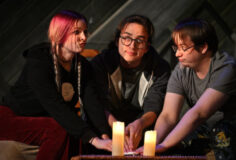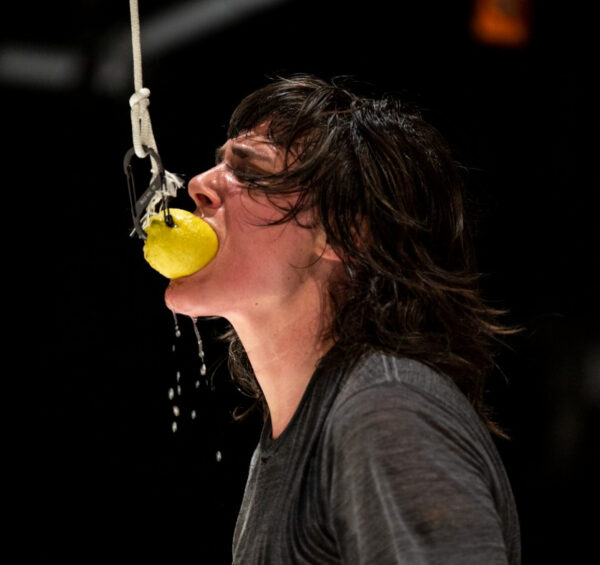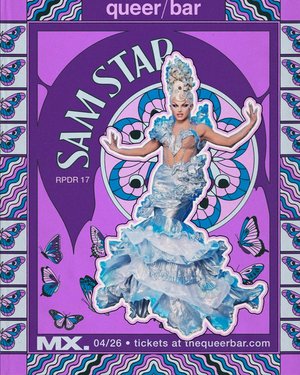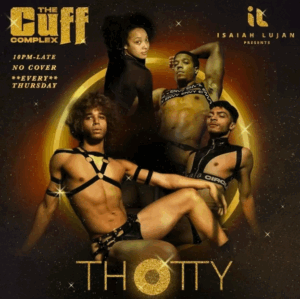“Young people with problems” is the thread (and a rather simplistically common one at that) that ties together two local theater productions on area stages. ACT offers up a work that examines the woes of a young deaf upper middle class British man dealing with the complexities of life as a deaf man and the annoyances of having a problematic home life while the play at ArtsWest goes a slightly different route with a young black working class American woman dealing with the complexities of life as a poor black teenager and the annoyances of having a problematic home life.
Review: Milk Like Sugar by Kirsten Greenidge. Produced by ArtsWest. Directed by Malika Oyetimein. Scenic Design by Jenny Littlefield. Costume Design by Kelsey Rogers. Lighting Design by Alyssa Millione. Sound Design by GOODSTEPH. With Allyson Lee Brown, Andre G. Brown, Marlette Buchannan, Nastacia Guimont, Jay O’Leary, Lindsay Zae Summers, and Dimitri Woods. Now through March 25, 2017 at Arts West Playhouse and Gallery.
We’ll start with the ArtsWest production, MILK LIKE SUGAR by Kirsten Greenidge, an up and coming young playwright whose work focuses on issues of race and economics. Here she draws on a real life controversy from nearly a decade ago when 17 girls at Gloucester High School in Massachusetts all made a pact to get pregnant and raise their babies together. “Milk Like Sugar” narrows that down to a trio of girls living in an unspecified city where the already pregnant Margie and the aggressively streetwise Talisha are sensing some hesitation on the part of their more thoughtful friend Annie to stick to their plan. All three girls have visions of benefiting from group baby showers that would surely include Coach bags and iPhones as part of their “loot” and seem to be under the impression that motherhood would be a lark largely consisting of dressing up their babies in designer clothes.
While Talisha pursues an unhealthy relationship with an older and rather dubious boyfriend, Annie has her eye on Malik, a quiet lowkey scholar with a love for astronomy and more interested in a real relationship with Annie rather than just being the sperm donor that Annie requires to get pregnant. Annie is also distracted by a crush on Antwoine, the apprentice tattoo artist working on her new tattoo as well as a new friend, Keera who offers up visions of a happy home life with loving parents, nightly family dinners and the warm embrace of her evangelical church. The visions of a happy home life give Annie hope she can salvage the distant relationship she has with her own mother Myrna who seems to spend all of her time chain smoking and dreaming of escaping the confines of her own unhappy life.
It’s a taut ensemble and “Milk Like Sugar” briskly tells its story in about 90 minutes and the play neatly cuts between familiar locations in Annie’s world: the tattoo shop where the girls meet to make their plans; a hallway at school; a private outdoor rendezvous spot to meet Malik; the kitchen in Annie’s home. As the play progresses, the hopes and the dreams of most of the characters aren’t always realized to the ideal outcomes and some reveal the truth behind the facades they present to the world. Kirsten Greenidge has created interesting and vibrant characters and a compelling plot and there is much to like with this play but…it does have some issues. Both male characters are on the underwritten side (Antwoine the tattoo artist in particular doesn’t get much to do…he really has ONE function in the play). And, there are times when it does feel a bit like an MTV/BET co-production teen soap opera with so many plot lines and twists but not really sufficient development or resolution for most of them. And, frankly, I think Ms Greenidge cops out with her ending. Yes, it would appear you only have two possible outcomes to Annie’s situation but there are perils with choosing either (she gets pregnant/she doesn’t get pregnant) but the ending as is feels a bit rote. You wish the playwright had worked on it a bit more to find a more complex solution. It doesn’t have to be a neat and tidy resolution but the fascinating characters deserve more than the “let’s wrap it all up!” ending the play has now.
All that said, I very much enjoyed this production. Director Malika Oyetimein has been “one to watch” for the last couple years gaining our attention in summer of 2015 with her superb staging (for Intiman) of Robert O’Hara’s “Bootycandy”. There’s similar strong staging here with an imaginative use of movement to propel the story in a series of interstitial moments between scenes where the actors engage in choreographed movement to music. I do think the play starts off a bit louder/faster than it needs to be; the first scene features the three girls animatedly discussing their plan and it’s a busy cacophony of sound and movement that does set the energy level and pace to the production but it’s also just the slightest bit too loud and fast to understand what the characters are saying…at least to middle aged ears.
It’s a very strong cast led by Allyson Lee Brown’s sweetly conflicted Annie who knows she would prefer romance to fornication and knowledge over ignorance yet struggles with the temptations to follow easier but more shallow routes on her journey. Annie has to struggle with choices and Ms Brown’s performance perfectly captures those struggles as she copes with all her different relationships with the other characters.
And, this is a strong ensemble with fine work from Andre G. Brown as the sweetly hesitant budding tattoo artist; Nastacia Guimont as the silliest of the three girls, Margie; Dimitri Woods as the studious and kindly Malik. Lindsay Zae Summers gives her Keera just the right amount of heartbreaking optimism to cope with the sad reality of her life. Marlette Buchannan’s mom Myrna is bitterness personified; she doesn’t know how to not be that kind of person anymore and it’s killing her relationship with her daughter. The scenes between mother and daughter are especially tough but dramatically very compelling due to the performances of the two actresses.
But, it’s Jay O’Leary as the tough talking Talisha who really threatens to steal the show. It’s a fresh but gritty take on a character that could end up being a bit of a cliche but Ms O’Leary does such a terrific job of finding the humanity in the character and imbues Talisha with a sense of honesty and tenderness hidden underneath the bravado of her outer persona. It’s a very compelling performance and her confessional moment towards the end of the play is one of the drama’s strongest moments.
Design wise, it’s a strong show with an effective but simple scenic design by Jenny Littlefield and and a very attractive lighting design from Alyssa Millione. Goodsteph’s sound design makes strong use of popular music and Kelsey Rogers’ costumes capture the characters superbly.
Though it does veer into teen soap opera land with a “meh” ending, MILK LIKE SUGAR is a compelling and fascinating look into the lives of these characters. The strong acting, directing and design elements make it very worth your time to check out.
Review: Tribes by Nina Raine. Produced by ACT. Directed by John Langs. Scenic Design by Shawn Ketchum Johnson. Costume Design by Rose Pederson. Lighting Design by Andrew D. Smith. Sound Design by Brendan Patrick Hogan. Projections Design by Tristan Roberson. Sign Master: Ryan Schlect. With Anne Allgood, Kjerstine Rose Anderson, Joshua Castille, Frank Corrado, Lindsay W. Evans, and Adam Standley. Now through March 26, 2017 at ACT.
Across town and across the pond we arrive at ACT’s just opened production of the British playwright Nina Raine’s UK set family drama TRIBES which focuses on a family several rungs up the socio-economic ladder as well as several degrees LESS realistic than the lives portrayed in “Milk Like Sugar”. Billy, the central character in this play, has plenty of similar issues to deal with: the desire to find a mate as well as coping with a dysfunctional family but Billy has the added disadvantage he has to do so while coping with being born deaf.
Billy seems to be relatively resigned to being deaf but also hasn’t had much contact with the deaf community. Billy’s opinionated and bigoted father has refused to allow Billy much interaction with other deaf people and discouraged his son from learning sign language. His family loves him, but Billy is treated more like a elderly pet than an equal member of the household which in addition to dad and mum, includes his older sister Ruth, a frustrated singer and his older brother Daniel, a grad student struggling with issues of his own. When Billy meets Sylvia, a young woman from a deaf family who herself is slowly going deaf, his world changes as he falls his love with both Sylvia and the joys of discovering a life outside his claustrophobic family and within the deaf community itself. But this change in Billy’s life has dramatic consequences on not only himself, but his family.
There’s much to like about “Tribes”…and, much to also NOT like about “Tribes”. Nina Raine has done a terrific job of creating a charming and fascinating relationship between Billy and Sylvia. Their scenes of meeting, falling in love and dealing with the complications of their lives is the best part of this play. It’s interesting and compelling and you really care about these two characters as Billy discovers he is part of a different “tribe” than just his family and Sylvia has to cope with her own fears of her increasing deafness.
The chief problem with “Tribes” is the rest of the play and the very annoying family that feels more like cardboard characters from a bad sitcom than actual fully realized flesh and blood beings. Billy feels real and Sylvia feels real but the shrieking, screaming ham handed antics of Billy’s family do not. Ms Raine seems to think that these broad characters are an important part of telling Billy’s story but she never makes them feel connected to the play’s other plot thread, the relationship between Billy and Sylvia. The playwright sets up the family members as vital characters but then ends up dismissing most of them (except for the troubled brother) by the end of the play. She creates these plot points and dynamics with the father figure but doesn’t follow through with them. And, oddly, for a female playwright, both the mother and the sister characters are underwritten and ill defined. They don’t really have much to do other than mope and be door mats for other characters.
The actors are all fine however with excellent work from Joshua Castille as Billy and Lindsay W. Evans as Sylvia. Their scenes are the best in the play largely due to the better writing but also because both young actors are just superb in their roles. Mr. Castille has been cast from out of Seattle (but we hope he comes back for other productions) but Ms Evans is local and she’s just a revelation in this role. She’s mostly played parts in smaller theater companies so hopefully her terrific work here is noticed and she will get better/bigger roles in more productions. We need to see more of her.
The “horrid” family is horrid because of the writing but the actors are all quite good with the usual superb work from Anne Allgood as the mostly benign mother and Frank Corrado as the rather awful father. Kjerstine Rose Anderson doesn’t get enough to do as the poor pathetic sister while Adam Standley’s Daniel probably gets TOO much to do; his character takes rather a lot of drastic twists and turns over the 90 minutes of this play. As usual, Mr. Standley is compelling and makes the most out of a role that requires rather an excessive amount of odd quirks. His relationship with Billy is the only remotely tender and compelling one within the confines of that dysfunctional family’s sitcom inspired dynamic.
So, you have two main threads in this play but only one works very well…one satisfies and the other irritates. Which makes for a mixed night of theater because I loved the one thread and didn’t like the other at all but I’ll be kind and recommend checking out “Tribes” because the good parts ARE very good and all the actors are good and it’s a handsome looking production and it’s quite good when the playwright lets it be good…which isn’t often enough.


